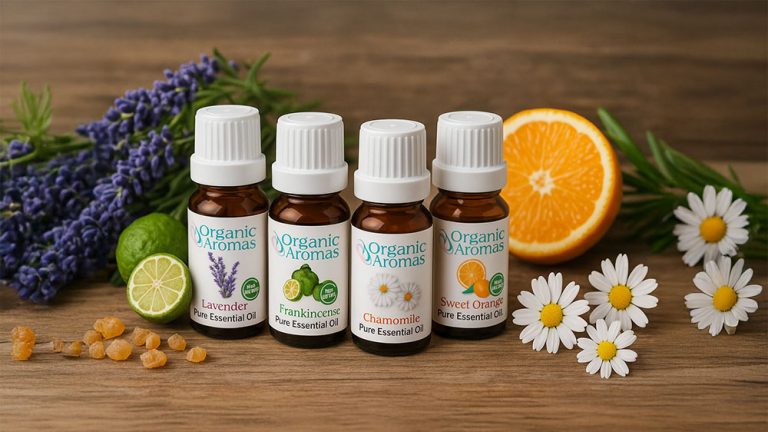The Best Carrier Oil for Essential Oils
Have you ever felt that dreamy lavender massage slip away after just a few breaths? Carrier oils (oils that help essential oils sink into your skin) keep that pure aroma locked in. It’s like wrapping a soft blanket around every drop of lavender goodness. These oils, pressed from nuts, seeds, and fruits, deliver fatty acids, vitamins, and antioxidants straight to your pores. And they don’t clog or leave a greasy feel.
Here we will explore the five best carrier oils to pair with your essential oils so your blends stay rich, nourishing, and oh-so-smooth every time.
Comparing the Top Carrier Oils for Essential Oils Dilution
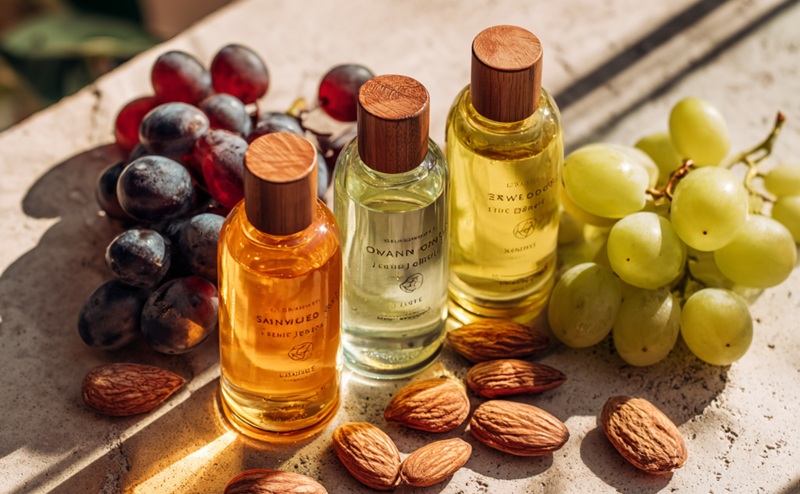
Carrier oils (also called fixed oils) come from the fatty parts of nuts, seeds, and kernels. These gentle vegetable oils don’t evaporate like essential oils – they help you spread strong extracts safely so your skin stays calm and gets every drop of goodness. Want to learn how cold-pressed oils hold on to more nutrients and organic purity? Check out types of carrier oils for essential oils. Think of these oils as a soft blanket for your aromatherapy and massage rituals.
When we pick a carrier oil, we look at its nutrient makeup like Omega-3, ‑6, and ‑9 fatty acids (healthy fats that feed your skin), plus fat-soluble vitamins (nutrients that blend right into oils) and antioxidants that protect your glow. You’ll also notice how fast it absorbs – quick for oily skin, slow for extra hydration – and how neutral it smells so your essential oil mist stays pure.
| Oil | Fatty Acid Profile (key fats) | Absorption Rate (skin soak time) | Aroma Neutrality (scent strength) |
|---|---|---|---|
| Jojoba | Omega-9 (a monounsaturated fat that mimics sebum) | Moderate-fast | High |
| Sweet Almond | Oleic (62%), Linoleic (25%) (healthy fats) | Medium | Moderate |
| Fractionated Coconut | Medium-chain triglycerides (light fats) | Fast | High |
| Grapeseed | Linoleic (~70%) (a polyunsaturated fat) | Fast | High |
| Avocado | Oleic (~65%), Linoleic (rich, nourishing fats) | Slow | Low |
Jojoba oil feels super smoot and ultra fine on the skin. It absorbs moderately fast, so it’s great for sensitive and acne-prone skin. And it resists rancidity (going bad), giving you months of fresh use. People often find jojoba the best carrier oil for essential oils.
Fractionated Coconut oil (a coconut oil processed to stay liquid) dries quickly on your skin. Its neutral scent lets your essential aromas shine. It’s feather-light, never greasy. Perfect for blends where you crave pure brightness.
Grapeseed oil glides on and sinks in fast, thanks to high linoleic acid (a nourishing polyunsaturated fat). That makes it ideal for oily skin, helping balance excess shine. You’ll feel a light astringent touch, like a soft spring breeze. Then your essential oils can ripple out fresh.
Avocado oil is rich and creamy, slow to absorb so you get deep moisture. Its high oleic content (a fatty acid known for hydration) nourishes dry or mature skin layers. It’s like a hydrating blanket at bedtime. Soft, calming, it preps your skin for rest.
Sweet Almond oil slips on smoothly with medium absorption. Packed with vitamin E (a skin-loving antioxidant), it leaves a silky finish. It’s the go-to oil for massage or daily rituals. Imagine a gentle caress that invites you to unwind.
Jojoba Oil Carrier Benefits: Mimicking Skin’s Natural Oils

Jojoba oil is technically a wax ester – a liquid wax that closely resembles human sebum, making it highly compatible with the skin. Its blend of esters (natural fatty compounds) and fatty acids feels like an extension of your skin, no tug, just harmony. Each drop brings vitamins A, D, and E along with a gentle fungicidal (helps fight tiny microbes) touch that soothes and protects.
As a carrier oil (a neutral oil that carries essential oils into your skin) for sensitive skin, Jojoba Oil absorbs just right. It sinks in moderately fast, delivering your favorite essential oil extracts deep down without any greasy feel. This balance helps regulate sebum production, clears pores, and calms acne-prone spots. It’s heat-stable and stays fresh up to five years, so your blends never go off.
Its molecular structure is very similar to human sebum, the natural oil our skin produces. This similarity helps jojoba oil:
- Balance skin’s oil production
- Absorb easily without clogging pores
- Be less prone to oxidation (giving it a long shelf life)
Aim for a 1 to 5 percent dilution of essential oils in jojoba oil. For daily use, a 1 percent dilution is gentle and skin-friendly. That equals about 5 to 6 drops of essential oil per ounce of jojoba. If you need occasional or more targeted support, you can go up to 5 percent, which is around 25 to 30 drops per ounce. This higher concentration is best used short-term and on smaller areas of the body.
For extra repair, mix Jojoba Oil with rosehip or castor oil in a 3:1 ratio. Your skin will drink it in, and the scent of your essential oils stays clear and bright with each use.
Sweet Almond and Fractionated Coconut: Neutral Carriers for Essential Oils
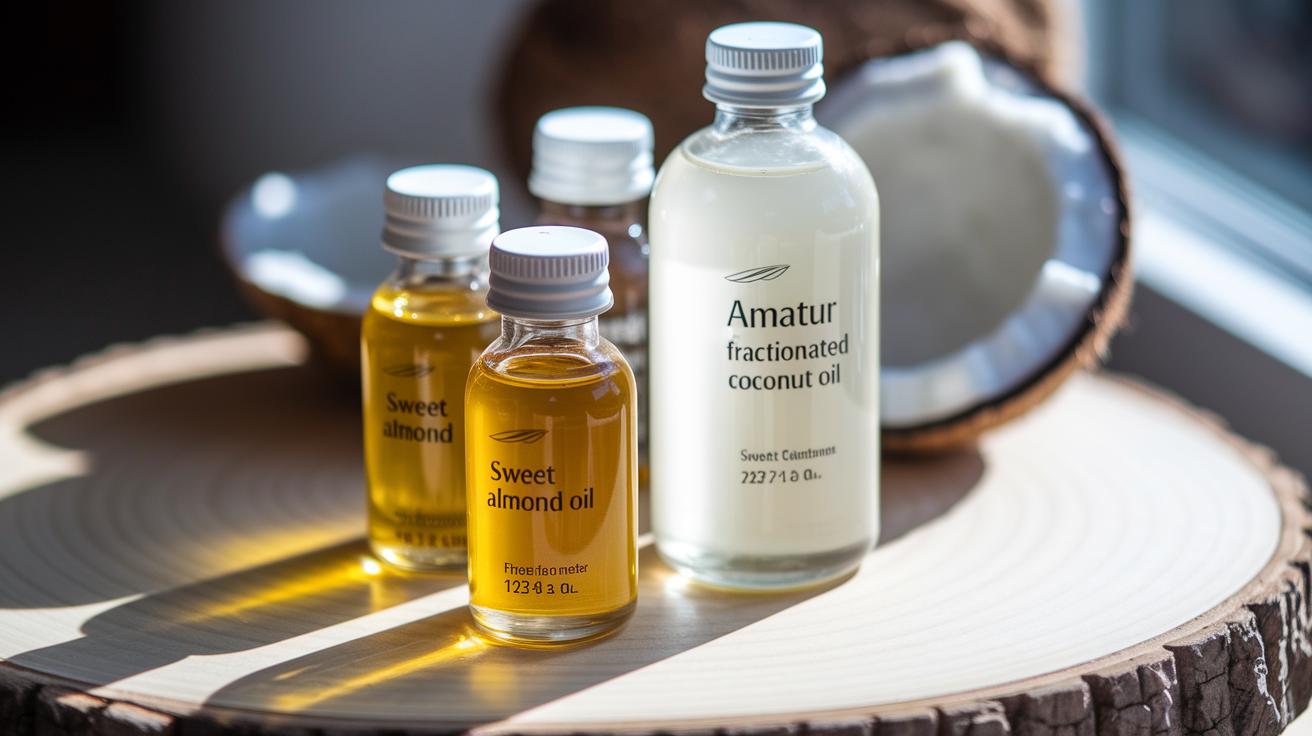
Sweet Almond Oil absorbs at a medium pace. It’s rich in oleic acid (a softening fat), linoleic acid (an omega-6 that helps protect your skin) and vitamin E. Fractionated Coconut Oil is a clear, odorless MCT oil (a light carrier oil that sinks in fast).
Next we aim for a safe 2 to 3 percent dilution in our blends. That’s about 10 to 15 drops of essential oil per ounce of carrier. This way your skin gets soothing benefits without any irritation.
- For a scalp pick-me-up, mix 12 drops of rosemary or peppermint oil into one ounce of fractionated coconut oil. Rub the blend in your palms until it feels warm, then massage gently at the roots. You’ll feel a fresh ripple of herbal aroma that sparks circulation and supports hair growth.
- For a calming body ritual, stir 15 drops of lavender or chamomile oil into one ounce of sweet almond oil. Glide it over tense muscles in slow, circular strokes. Breathe in the soft murmur of botanicals drifting across your skin.
| Recipe | Carrier Oil | Essential Oil | Dilution Ratio |
|---|---|---|---|
| Scalp Energizer | Fractionated Coconut Oil | Rosemary or Peppermint | 2% (12 drops per oz) |
| Calming Massage | Sweet Almond Oil | Lavender or Chamomile | 3% (15 drops per oz) |
Grapeseed, Argan, and Avocado Oil Carrier Profiles
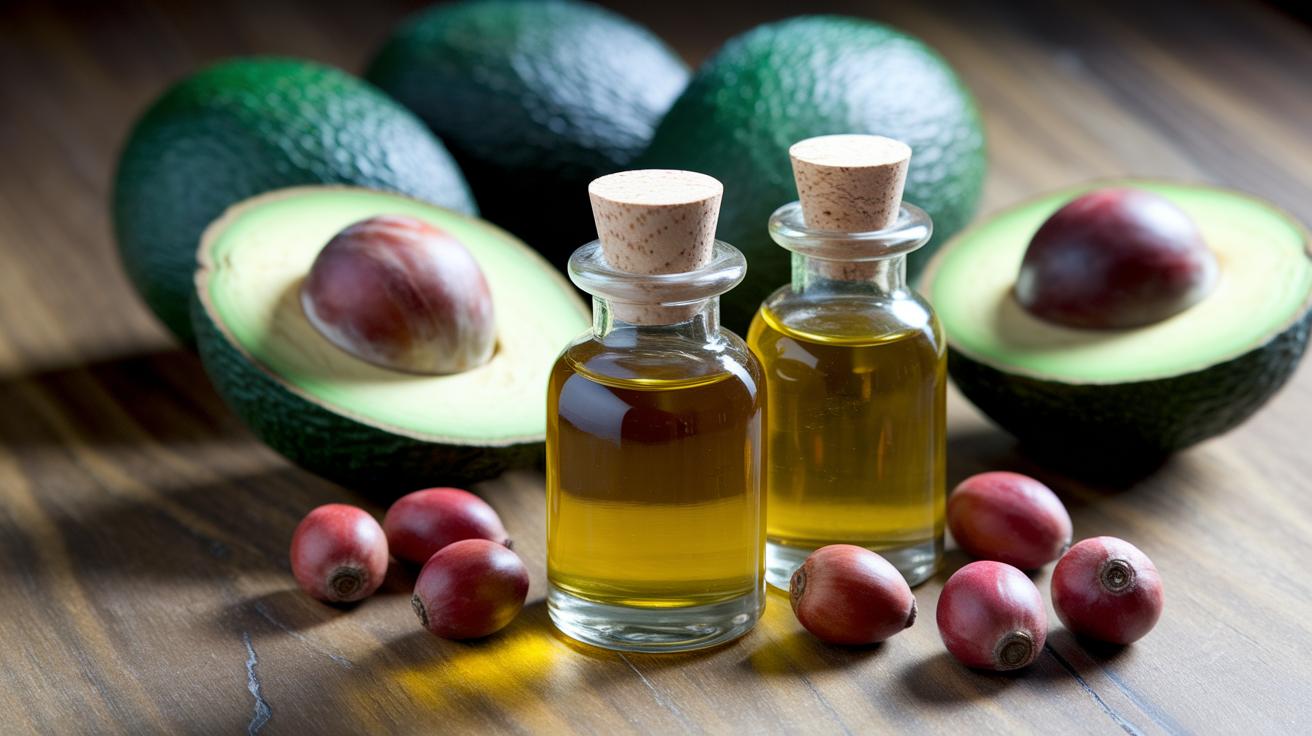
Grapeseed oil is feather-light and fast-absorbing, packed with linoleic acid (a fatty acid that helps balance oily skin). Have you noticed how it soaks in without leaving a greasy feel?
Avocado oil brings deep, slow hydration thanks to its high oleic acid (a nourishing fatty acid). It’s perfect for dry or mature skin, giving a rich, cushion-like feel.
Argan oil carries a gentle nutty scent and a balanced fatty-acid profile, about 50% oleic acid, 35% linoleic acid, plus palmitic and stearic acids. It’s loaded with antioxidants (vitamin E and phenolic compounds that protect skin cells), smoothing fine lines and boosting elasticity. Store it in a cool, dark spot and you’ll enjoy peak freshness for up to three years.
Mix rosehip oil (rich in linoleic and linolenic acids plus vitamin A for gentle cell renewal) with Argan or Jojoba oil to target scars, uneven tone, and fine lines. Its silky texture brings a subtle glow without clogging pores.
| Oil | Key Fatty Acids | Best for | Shelf Life |
|---|---|---|---|
| Grapeseed | ~70% linoleic acid | Oily, acne-prone | 6–12 months |
| Avocado | ~65% oleic acid | Dry, mature | 8 months (refrigerate) |
| Argan | 50% oleic, 35% linoleic acid | Mature, sensitive | 3 years |
| Rosehip | 44% linoleic, 30% linolenic acids | Scars, uneven tone | 6 months (fridge) |
Advanced Blends
Storage tips
- Keep oils in amber bottles away from heat and light
- Refrigerate rosehip and any avocado blends
Dilution ratios for a 1-oz (30 ml) base
- 2% dilution = 12 drops essential oil
- 5% dilution = 30 drops essential oil
Blend ideas
- Argan + Rosehip (1:1) with 4 drops frankincense for smoothing lines
- Rosehip + Jojoba (2:1) with 6 drops lavender for a daily glow
- Grapeseed + Rosehip (3:1) with 8 drops tea tree to help control blemishes
Tailoring Carrier Oil Selection to Skin Types and Aromatherapy Uses
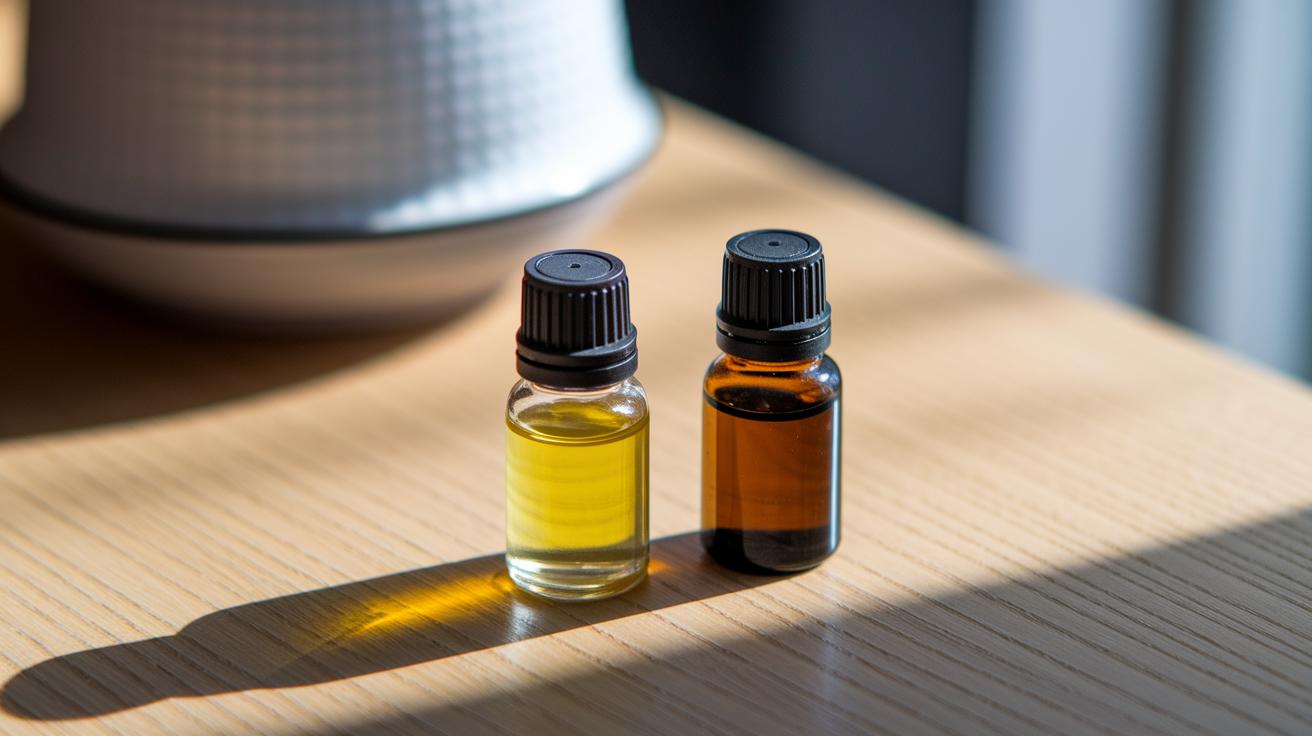
At Organic Aromas, we love helping you find pure carrier oils for your skin and aromatherapy (using plant scents to help your mood). Each one is cold-pressed (oil squeezed without heat to keep nutrients) and ethically sourced. Next, let’s explore three lesser-known oils and see which skin types they love.
| Carrier Oil | Feel & Soak-In | Best For |
|---|---|---|
| Hazelnut | Light and fast-soaking | Oily or acne-prone skin |
| Macadamia | Medium thickness, nourishing | Dry or mature skin |
| Shea | Rich and slow-soaking | Extra dry or flaky skin |
Ready to level up your blends? Your skin and senses will thank you.
- First, mix 1–2 drops of Blue Tansy (an essential oil high in chamazulene, a compound known for soothing redness) into each teaspoon of carrier oil. Watch the mist turn deep blue. It’s calming for skin that feels inflamed.
- Next, pour a few drops of hazelnut oil into your palms. Rub your hands together until you feel a soft, nutty warmth. Then press gently into your T-zone. Your skin will soak it up fast, leaving a matte feel.
- For an overnight glow, blend equal parts macadamia and shea oils. Stir in one drop of Blue Tansy. Sleep on it and wake up to plump, even skin.
- If you love a good massage, pour a little macadamia oil into your hands. Feel the soft slide as you move. Let the light sheen sink in for a gentle, lingering glow.
Experiment with these oil profiles and notice how each scent and texture ripples through your self-care ritual.
Essential Oil Dilution Ratios and Carrier Oil Storage Best Practices
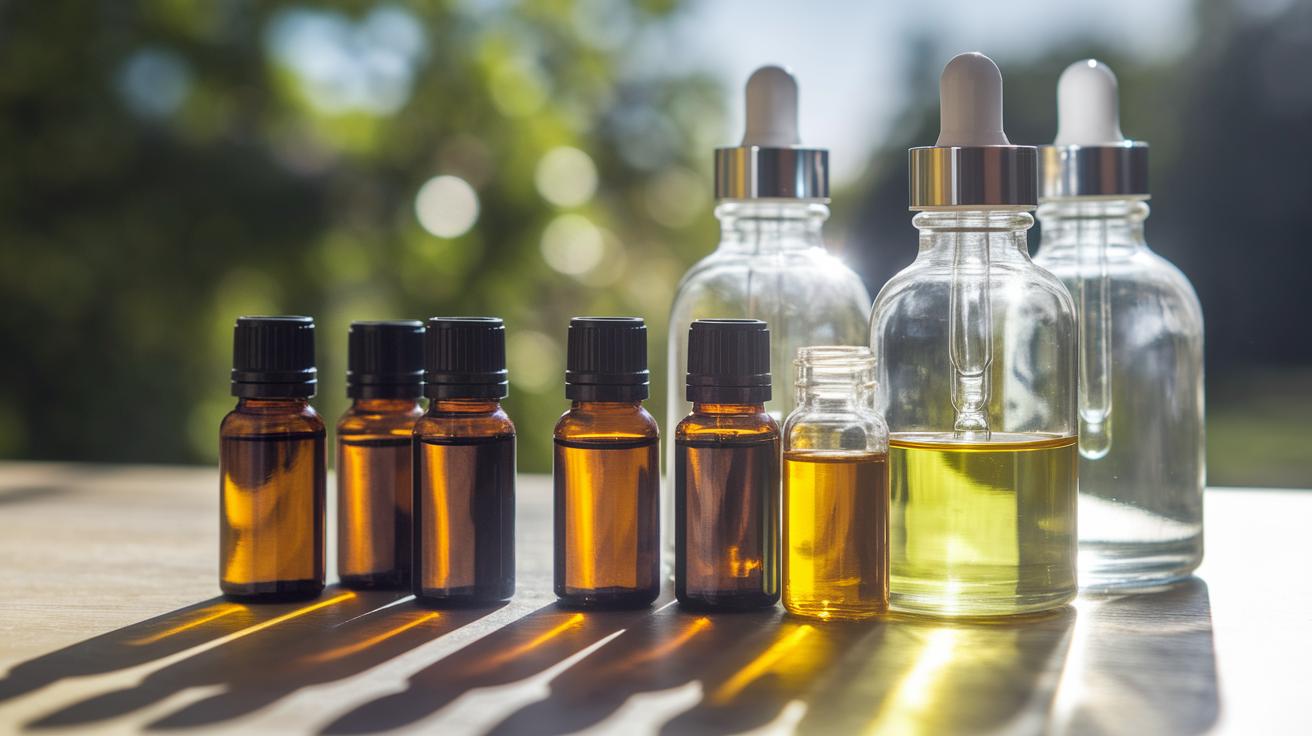
When you blend essential oils you want that aroma to drift softly around you and your skin to feel calm. It’s all about the dilution ratio (how many drops of essential oil you add per ounce of carrier oil (a neutral oil that carries the scent)). Then check the essential oil dilution calculator (our handy tool) to see the exact drop count.
| Blend Strength | Drops per Ounce | Notes |
|---|---|---|
| 2% (adults) | 10 drops | Patch-test (skin test) 24 hours before using. Use a clean glass bottle. Label with the date. Refrigerate heat-sensitive oils like rosehip. |
| 1% (kids, seniors, sensitive skin) | 5 drops | Patch-test (skin test) 24 hours before using. Use a clean glass bottle. Label with the date. Refrigerate heat-sensitive oils like rosehip. |
- Swirl the bottle gently so the oil drops disperse evenly.
- Label each mix with the date. Then store heat-sensitive oils like rosehip in the fridge.
For the Best Carrier Oil for Essential Oils Experiment!
We explored how carrier oils dilute essential oils, why nutrient profiles matter, and which ones suit different skin types and uses.
From jojoba’s sebum-like balance to sweet almond’s massage glide, and avocado’s deep hydration, each oil brings unique benefits.
We also shared dilution ratios, storage tips, safety steps, and blend ideas.
You now have clear criteria to choose the right blend for calm, focus, or pampering.
Enjoy experimenting with your next custom mix to find the best carrier oil for essential oils.
FAQ
Frequently Asked Questions
What is the best carrier oil for diffusers and perfumes?
The best carrier oil for diffusers and perfumes is fractionated coconut oil. It’s colorless, odorless, and holds fragrance molecules well, so you get a long-lasting, even aroma in your room or mist.
What is the best carrier oil for skin and face?
The best carrier oil for skin and face is jojoba oil. It mimics your skin’s natural sebum, absorbs at a moderate speed, and balances moisture without clogging pores or leaving a greasy feel.
List of carrier oils and their benefits
Common carrier oils include:
- Jojoba (mimics sebum)
- Sweet almond (rich in vitamin E)
- Grapeseed (light and astringent)
- Fractionated coconut (quick-absorbing)
- Avocado (deep hydration)
- Argan (anti-aging antioxidants)
What is the best carrier oil for hair?
The best carrier oil for hair is sweet almond oil. It’s rich in oleic acid and vitamin E, glides easily through strands, adds shine, and helps strengthen roots without weighing hair down.
Which carrier oil is best absorbed by the skin?
Fractionated coconut oil is best absorbed by the skin. Its medium-chain triglycerides let it sink in fast, leaving skin soft and non-greasy—ideal for massage or daily hydration.
What is the 30/50/20 rule for essential oils?
The 30/50/20 rule means you blend 30% top notes, 50% middle notes, and 20% base notes. This balance creates a well-rounded scent that unfolds beautifully over time.





